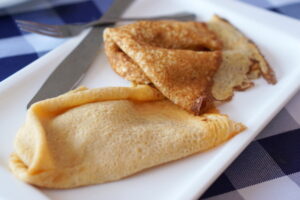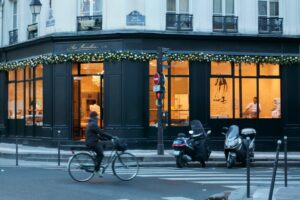Last Updated on November 29, 2025 by | Published: June 11, 2019
Sure, you can always have a flaky croissant, or perhaps a few buttery madeleines to start your day. But when it comes to the perfect French treat—at any time of the day—we have to go with the heavenly macarons.
That delicate crunch, followed by a lusciously chewy center and a creamy finish? Perfection. Ethereally light and airy, once you’ve tried these colorful delights, you won’t be able to stop thinking about them.
Macarons are created with high-end ingredients through a delicate process. The French-born, cream-filled confection is an international icon and symbol of the sweet life in Paris, thanks in part to the Paris-based pastry giant Ladurée.
Read along to learn more about everyone’s favorite French sweet treat, macarons.
One bite and you’re hooked. Photo credit: Jocelyn & Cathy
Where did macarons come from?
The origin of this cookie-slash-pastry may have been in Italy, but it was consecrated in 16th-century Paris. That’s when that one-woman arbiter of taste, Queen Catherine de’ Medici (an Italian queen of France), instructed her French pastry chefs on the finer points of sweets.
That’s one version of the story, at least. Another version traces the birth of the macaron to a French Carmelite convent in the late 18th century. It’s said that the nuns dreamed them up for an early version of a bake sale to raise money for the convent’s upkeep.
This popular pastry floats at least two other origin stories. What seems certain is that Ladurée, Paris’s first combined tearoom and pastry shop, was also the first to mass produce the pastry in several flavors and colors.
Since the 1870s, Ladurée has been synonymous with delectable sweets, playing a significant role in the resurgence of macarons by fostering an old-world Parisian charm. Their elegant sea-foam green boutiques and stands can now be discovered in department stores and airports across the globe.
French chefs have been perfecting macarons for centuries. Photo credit: Volodymyr Proskurovskyi
Evolution of the macaron
While Ladurée may have revived the macaron, rockstar pâtissier Pierre Hermé glamorized the pastry long before Marie Antoinette’s languid sugar orgy in Sophia Coppola’s film.
From its opening in 2001, foodies from near and far flock to Hermé’s boutiques for “haute couture” versions that change with the seasons. They come in such far-flung flavors as olive oil, mandarin, and red fruit and white truffle-hazelnut. Hermé’s cherished classics are the Ispahan, a rose-flavored biscuit, filled with rose-petal cream, fresh raspberry and lychee; and the Mogador, mixing milk chocolate and passion fruit. Many swear by his heavenly salted caramel macaron.
“These are products that provide emotion,” Hermé told the French paper L’Express. “Our job as pastry chefs is to please. There is nothing worse than eating a dessert and nothing happens.”
From the classic chocolate to more modern versions such as rose-petal cream, you can now try a wide variety of delicious macaron flavors. Photo credit: Omar Chatriwala
A day to celebrate macarons
Since Hermé started, the pastry has exploded onto the scene, showing up everywhere from the top gourmet bakeries to McDonalds. You can find macaron versions that range from the sublime (violet-cassis at Sébastien Dégardin) to the delirious (Petrossian caviar and walnut liqueur at Hermé).
Macarons are celebrated with their own special day in Paris called the Jour du Macaron, established by Hermé in 2005. Every year on March 20, Parisian pastry chefs showcase exciting new flavor combinations to celebrate. People can choose the macaron of their choice in return for a donation of any amount, all of which goes to a designated charity.
Everyday can be macaron day if you want it to be. Photo credit: Kuboki
Where to try macarons in Paris
Though the small but mighty macaron is a staple in every pastry chef’s repertoire, here are some names that consistently produce the best and most creative versions around town: Hugo & Victor, Sadaharu Aoki, Arnaud Larher, Laurent Duchêne, Maison Lenôtre, Fauchon and, of course, Pierre Hermé and Ladurée.
Most of these patisseries also offer chic gift boxes to bring some home. And in your quest to run around the city to try the best macarons, make time for some of the other famous food in Paris, too.
You can find macarons all over Paris, but the ones at Fauchon are some of the best in the city. Photo credit: Nan Palmero
Update Notice: This post was updated on December 19, 2023.
Craving macarons? Can’t blame you! Come try some of the best in Paris on our Paris Ultimate Food Tour. We’ll visit one of the few remaining authentic French pastry shops in Le Marais, and eight eateries. Join us!








